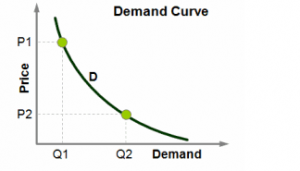
Rick Lester
Seat-o-nomics
Posted by Jul 19, 2012

Rick Lester
 Conventional wisdom: A higher price (P1) results in a lower quantity sold (Q1), whereas a lower price (P2) results in a more sales (Q2).
Conventional wisdom: A higher price (P1) results in a lower quantity sold (Q1), whereas a lower price (P2) results in a more sales (Q2).
Harry Truman famously expressed a desire to consult only with “one-armed economists." Our 33rd president wasn’t fond of counsel that began, "On the one hand, this…" and was followed by "On the other hand, that…" Truman wanted straight talk without equivocation.
So, here is a bit of economic straight talk from the data vaults of TRG Arts. Forget everything you learned in that Econ 101 class you took in undergraduate school. You can also forget what you learned at business school. It doesn’t apply to tickets.
Competitive Freedom
Conventional wisdom holds that higher prices reduce demand. For instance, in the consumer universe of unlimited hamburger availability, McDonald’s will sell many at $1.00 and many fewer at $10.00. And, at $100, demand goes to zero.
But, supply and demand curves do not apply to the world of selling tickets.
Those curves depend upon an “open market” of goods and prices. Corn, wheat, and hamburgers are sold in huge open markets. There are vast numbers of buyers and sellers who are free to compete for the exchange of goods and services.
Price subject to desire.
This condition of competitive freedom does not exist when selling tickets.
For example, nonprofit organizations are run by volunteer boards who set, approve or use their clout to influence prices—prices that these same board members pay when they attend the performances presented by their organization. That’s just one reason why the best seats are frequently undervalued.
Read More

 Adrion Porter
Adrion Porter

 Tim Mikulski
Tim Mikulski



 Nina Simon
Nina Simon




